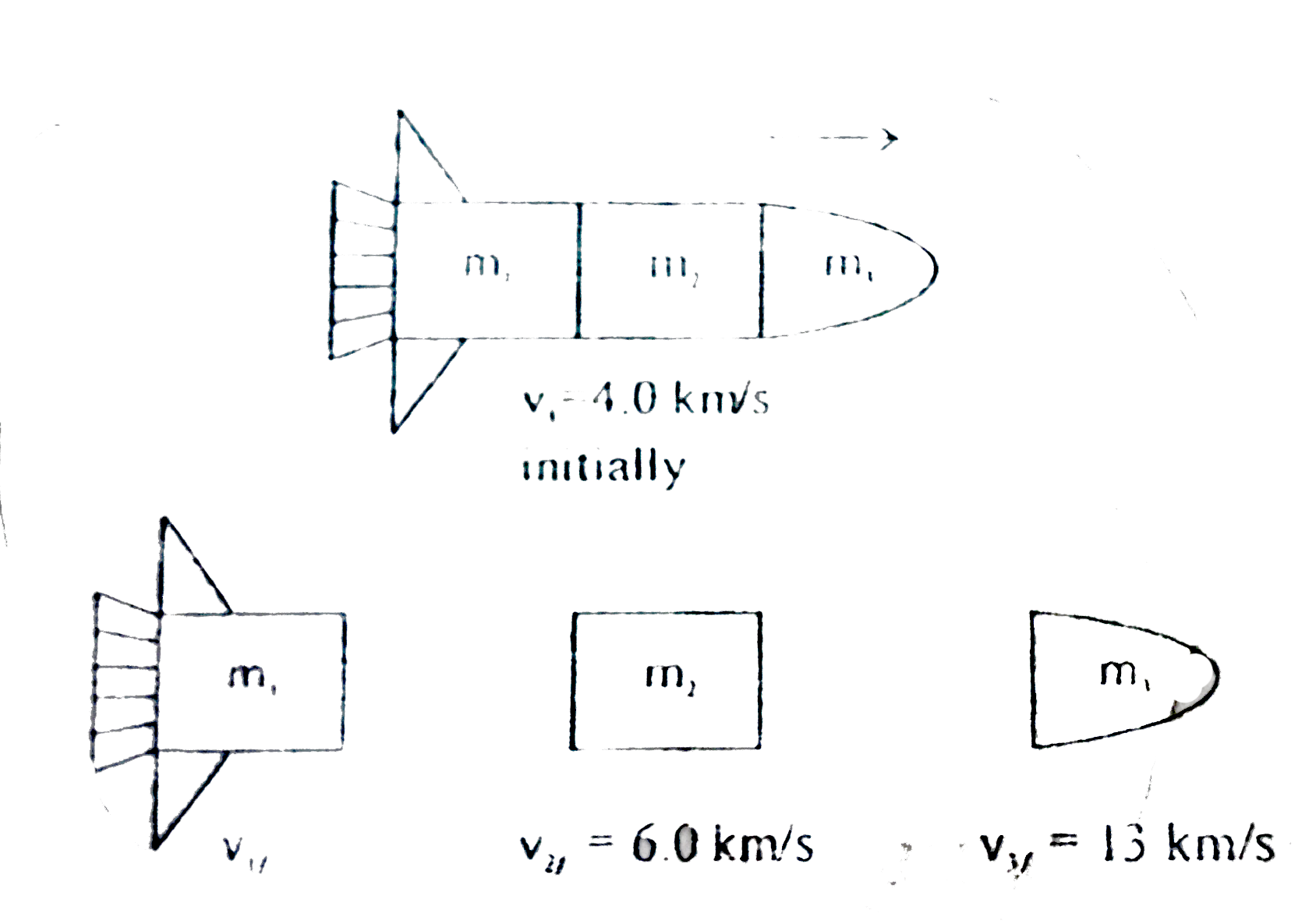A three part rocket begins intact as a single object in distant outer space, travlling to the right at . The first stage explodes away from the rear of the rocket, with an unknown final velocity . Later, the second stage explodes away from teh rear with a final velocity to the right at . The third stage ends up with a final velocity to the right of . (All three move only along the axis . Ignore gravity. Assume that all parts of the rocket have constant masses.)

What is the final velocity of the first stage. Solution in Gujrati
towards left
towards right
towards left
towards right
The correct Answer is:A
Ans.(1)
Topper's Solved these Questions
- TEST PAPERBOOK - ALLEN CHAPTER - TEST PAPEREXERCISE - PHYSICS
4 Videos
- TEST PAPERBOOK - ALLEN CHAPTER - TEST PAPEREXERCISE - PHYSICS
4 Videos
- SIMPLE HARMONIC MOTIONBOOK - ALLEN CHAPTER - SIMPLE HARMONIC MOTIONEXERCISE - Example
1 Videos
- TEST PAPER 1BOOK - ALLEN CHAPTER - TEST PAPER 1EXERCISE - PHYSICS
11 Videos
Similar Questions
Choose the correct statement:
View SolutionChoose the correct statement:
View SolutionA rod with rectangular cross section oscillates about a horizontal axis passing through one of its ends and it behaves like a seconds pendulum, its length will be
View SolutionWhy are electric field lines perpendicular at a point on an equipotential surface of a conductor ?
View SolutionA three part rocket begins intact as a single object in distant outer space, travlling to the right at 4.0km/h. The first stage (m1=950,000kg) explodes away from the rear of the rocket, with an unknown final velocity (vtf). Later, the second stage (m2=550,000kg) explodes away from teh rear with a final velocity to the right at 6.0km/s. The third stage (m2=350,000kg) ends up with a final velocity to the right of 13.0km/s. (All three move only along the x−axis . Ignore gravity. Assume that all parts of the rocket have constant masses.)

Find the impulse received by the first rocket stage.
View SolutionA double stage rocket has an initial mass M_(i) , gas is exhausted front he rocket at a constant rate of dm/dt and with an exhaust velocity u relative to the rocket. When the mass of the rocket reaches the value mu , the first stage of mass m of Which fuel is exhausted is disengaged from the rocket and then the rocket continues to the second stage at teh same rate and exhaust velocity as int eh first stage, until it reaches a mass M_(f) (a). Calculate the rocket velocity at the end of the first stage, given that it is started at rest. (b). Calculat ethe rocket velocity at the end of the second stage. ltbr> (c). What is the final velocity of a one stage rocket of the same initial M_(i) mass and the same amount of fuel ? it is greater or less than final velocity of the double stage rocket?
View SolutionTwo bodies having masses m_(1) and m_(2) and velocities v_(1) and v_(2) colide and form a composite system. If m_(1)v_(1) + m_(2)v_(2) = 0(m_(1) ne m_(2) . The velocity of composite system will be
View SolutionAt the beginning of the final stage of mitosis,
View SolutionThe first & second stage of two stage rocket separately weigh 100 kg and 10 kg and contain 800kg and 90kg fuel respectively. If the exhaust velocity of gases is 2 km/sec then find velocity of rocket (nearly) (log105=0.6990) (neglect gravity)
View SolutionThe first & second stage of two stage rocket separately weigh 100 kg and 10 kg and contain 800kg and 90kg fuel respectively. If the exhaust velocity of gases is 2 km/sec then velocity of rocket after second stage is (nearly) ( log_(10)5 = 0.6990 ) (neglect gravity)
View SolutionThe first & second stage of two stage rocket separately weigh 100 kg and 10 kg and contain 800kg and 90kg fuel respectively. If the exhaust velocity of gases is 2 km/sec then velocity of rocket after second stage is (nearly) (log_(10)5=0.6990) (neglect gravity)
View SolutionThe first & second stage of two stage rocket separately weigh 100 kg and 10 kg and contain 800kg and 90kg fuel respectively. If the exhaust velocity of gases is 2 km/sec then velocity of rocket after second stage is (nearly) (log_(10)5 =0.6990) (neglect gravity)
View SolutionThe first & second stage of two stage rocket separately weigh 100 kg and 10 kg and contain 800kg and 90kg fuel respectively. If the exhaust velocity of gases is 2 km/sec then velocity of rocket after second stage is (nearly) (log_(10)5 =0.6990) (neglect gravity)
View SolutionThe first & second stage of two stage rocket separately weigh 100 kg and 10 kg and contain 800 kg and 90 kg fuel respectively. If the exhaust velocity of gases is 2 km/sec then find velocity of rocket (nearly) (log105=0.6990) (neglect gravity).
View SolutionA double stage rocket has an initial mass M_(1) . Gas is exhausted from the rocket at a constant rate of dm/dt and with an exhaust velocity u relative to the rocket. When the mass of the rocket reaches the value 'mu' the first state of mass m is disengaged from the rocket then the rocket continues the second stage at the same rate (dm/dt) and exhaust velocity (u) as in the first stage unit it reaches a mass M_(f) . If gravity is neglected and the rocket has started from rest, the velocity of the rocket at the end of first stage is
View SolutionIn the above problem, what is the velocity of rocket after second stage ?
View Solution
